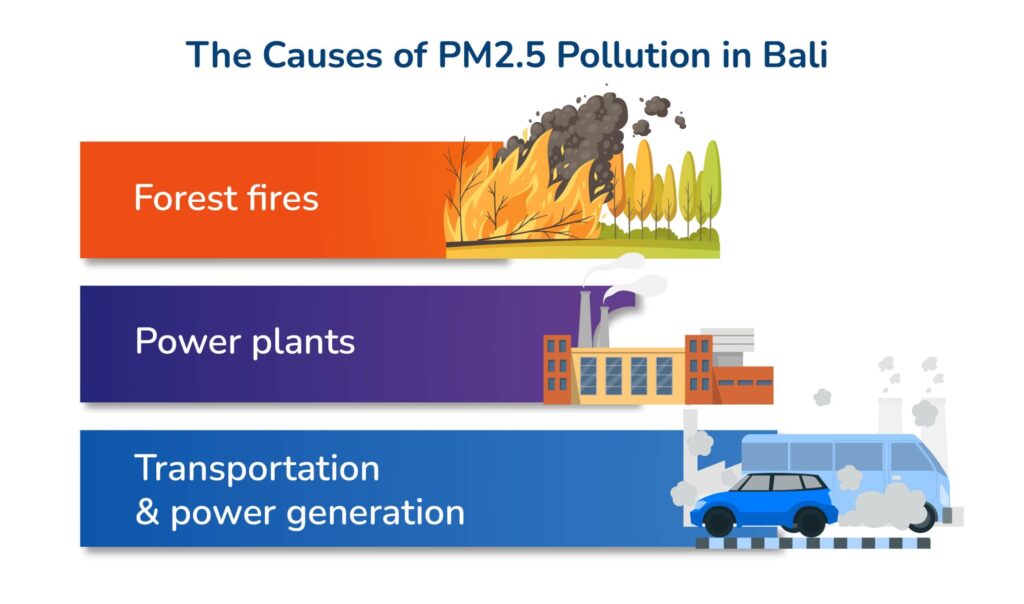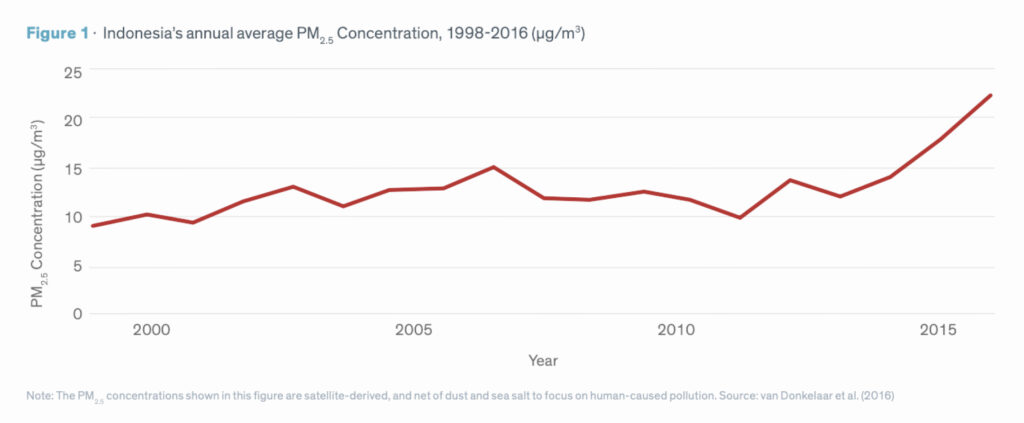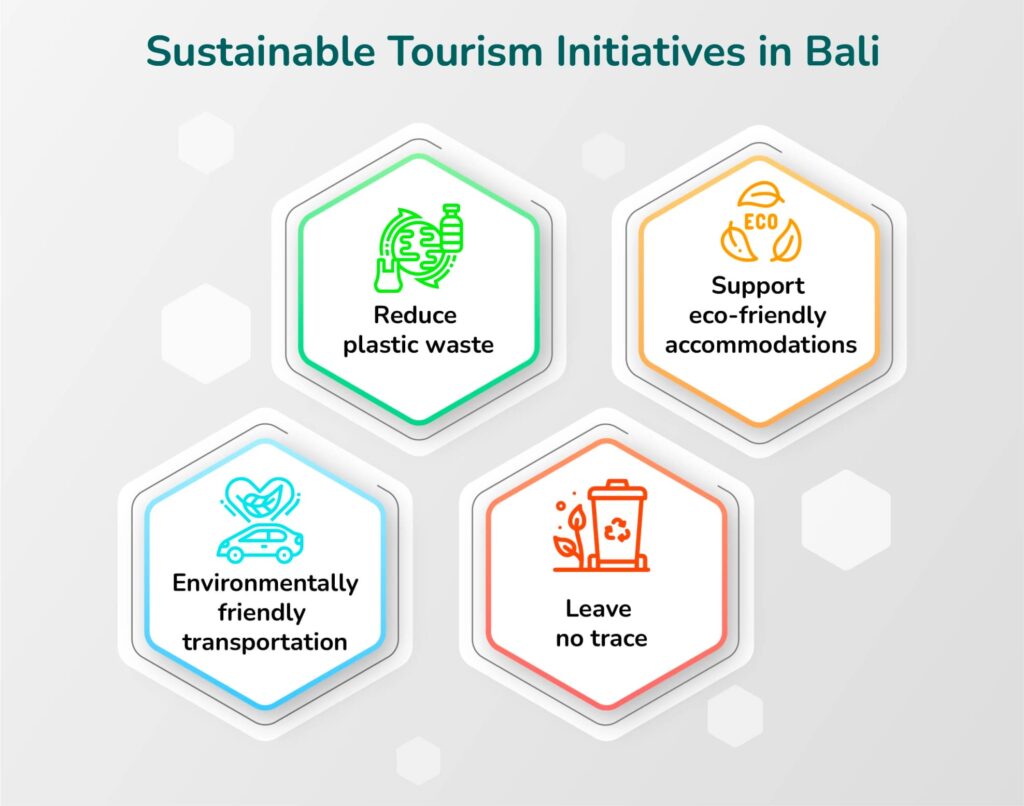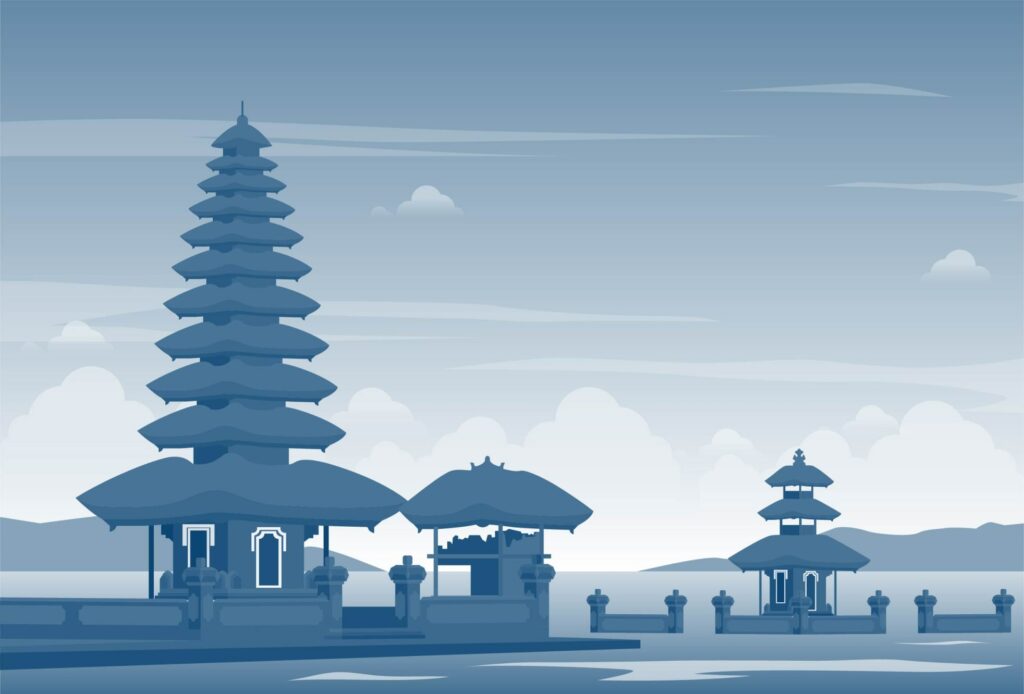Introduction
Bali’s natural beauty, diverse topography, and unique cultural heritage have made it a highly sought-after tourist destination for people worldwide. Surfing enthusiasts can catch the waves on Bali’s famous beaches. Whereas nature lovers can trek through the island’s lush green mountains. Additionally, Bali’s rich cultural offerings provide tourists with an opportunity to explore the island’s traditions, architecture, and cuisine. However, in recent years, the island has grappled with a serious environmental issue – PM2.5 pollution. The tiny particles are less than 2.5 micrometers in diameter. They can penetrate deep into the lungs and cause a range of health problems. In this article, I will explore the impact of PM2.5 pollution in Bali and on its tourism industry, its causes, and what can be done to address the problem.

The Impact of PM2.5 Pollution on Bali’s Tourism Industry
The tourism industry is a major contributor to Bali’s economy, with millions of visitors flocking to the island each year. However, PM2.5 pollution has started to take a toll on the industry. Many tourists are now hesitant to visit Bali, especially during the dry season when the pollution levels are at their highest. The haze that hangs over the island can be a major turn-off for visitors who come seeking clear skies and pristine beaches. In addition, the health hazards of PM2.5 pollution are also a concern for tourists, especially those with respiratory problems.
The impact of PM2.5 pollution is not just limited to tourism. It can also have a ripple effect on other industries, such as agriculture and fisheries. The particles can settle on crops and fish, making them unsafe for consumption. This can lead to a loss of income for farmers and fishermen, further exacerbating the economic impact of pollution.
The Causes of PM2.5 Pollution in Bali
PM2.5 pollution in Bali is caused by a combination of natural and man-made factors. Some of them are as follows:
- One of the main contributors is the burning of fossil fuels for transportation and power generation.
- The increase in tourism and industry has led to a rise in the number of vehicles and power plants, which emit harmful pollutants into the air.
- Forest fires in neighboring islands and countries, such as Sumatra and Java, also add to the pollution levels in Bali.
- Bali’s geography exacerbates the pollution problem as it is surrounded by high mountains that trap pollutants and hinder their dispersal.
- This vulnerability is particularly prominent during the dry season when there is little rainfall to cleanse the particles from the air.

PM2.5 Pollution Statistics in Bali
With current PM2.5 pollution levels, the Air Quality Life Index (AQLI) forecasts that the average Indonesian may lose 1.2 years of life expectancy due to poor air quality. This fails to satisfy World Health Organization (WHO) limits for fine particulate matter concentrations (PM2.5).

Particle pollution reduces Indonesians’ life expectancy by 4.8 years on average. Moreover, citizens of the Ogan Komering Ilir region face an even larger decline of 5.6 years on average. If 2016 pollution levels are sustained, the Indonesian population will lose nearly 309 million life-years to particle pollution, one of the world’s heaviest burdens. Just China, India, Pakistan, and Bangladesh have suffered more casualties in this regard.
The Health Hazards of PM2.5 Pollution
- PM2.5 pollution poses severe health risks, particularly for vulnerable populations such as children, the elderly, and individuals with respiratory issues.
- The tiny particles can penetrate deep into the lungs and trigger various health issues, such as asthma, bronchitis, and heart disease.
- Long-term exposure to PM2.5 pollution is linked to an increased risk of lung cancer.
- Wildlife, particularly marine life, is also affected by PM2.5 pollution. The pollutants can reduce the amount of sunlight that reaches the underwater ecosystem, disrupting the food chain and causing a decline in fish populations.
- These environmental and health concerns are negatively impacting Bali’s tourism industry.
The Government’s Response to PM2.5 Pollution in Bali
The Indonesian government has recognized the issue of particulate pollution and has initiated measures to tackle it. Although a unified PM2.5 standard is lacking at the national level, the Indonesian government’s efforts to address particulate pollution are an important initial step in reducing its detrimental impact. These measures could potentially lead to the development of a comprehensive framework for managing particulate pollution in the future.
- The govt. has focused its efforts mostly on the transport industry, which is a significant contributor to airborne pollutants in urban areas such as Jakarta.
- The Indonesian authority has stepped up its efforts to combat airborne pollutants produced by peatland and forest fires. After the Southeast Asian Haze in 2015, which caused health and economic harm, President Joko Widodo issued a ban on fresh peatland development and established the Peatland Restoration Agency (BRG).
- To meet rising energy demand, Indonesia has more than doubled its coal-fired electricity capacity since 2010. Nonetheless, as compared to other Asian countries, Indonesia’s rules on coal plant emissions remain relatively lenient.
Sustainable Tourism Initiatives in Bali
Several sustainable tourism initiatives in Bali are working to address the issue of PM2.5 pollution. Here are some sustainable and eco-friendly tips for tourists visiting Bali, Indonesia:
- Reduce plastic waste: Carry a reusable water bottle, shopping bag, and straw to avoid contributing to the plastic waste problem in Bali.
- Support eco-friendly accommodations: Choose to stay at eco-friendly accommodations that have adopted sustainable practices such as recycling, reducing water usage, and using renewable energy sources.
- Use environmentally-friendly transportation: Rent a bicycle or walk instead of taking a taxi or renting a motorbike to explore the island.
- Leave no trace: Dispose of your waste properly and avoid littering to help keep Bali’s environment clean and beautiful.

By following these tips, tourists can help minimize their impact on Bali’s environment and support sustainable tourism practices.
Future Outlook for Bali’s Tourism
In light of PM2.5 pollution, the future of tourism in Bali is rather uncertain. The tourism industry is a big contributor to Bali’s economy. High levels of pollution may reduce the number of tourists to the island. Nonetheless, initiatives are underway in Bali to tackle the pollution issue and further enhance air quality. This will further help to reduce the impact on tourism.
The Indonesian govt. is aware of the problem of air pollution. They have taken preliminary moves to address it, such as focusing on transportation and establishing the Peatland Restoration Agency. In addition, private organizations are launching a number of programs to support sustainability and eco-friendliness in Bali’s tourism business.
If these efforts are successful in improving air quality in Bali, it is likely that the tourism industry will continue to thrive. However, if pollution levels remain high and air quality does not improve, tourists may become increasingly hesitant to visit Bali. This will further lead to a decline in tourism and a negative impact on the economy.
Conclusion and Call to Action

In conclusion, PM2.5 pollution is a serious issue facing Bali’s tourism industry and the island’s environment. The causes of pollution are complex and require a multi-faceted approach to address.
As tourists, we can also do our part by supporting eco-friendly tourism initiatives and reducing our carbon footprint. By taking action to address the issue of PM2.5 pollution, we can help to protect Bali’s environment and ensure that the island remains a beautiful and sustainable destination for generations to come.
This post is also available in:
![]() Global
Global French
![]() IND English
IND English ![]() UK English
UK English ![]() US English
US English